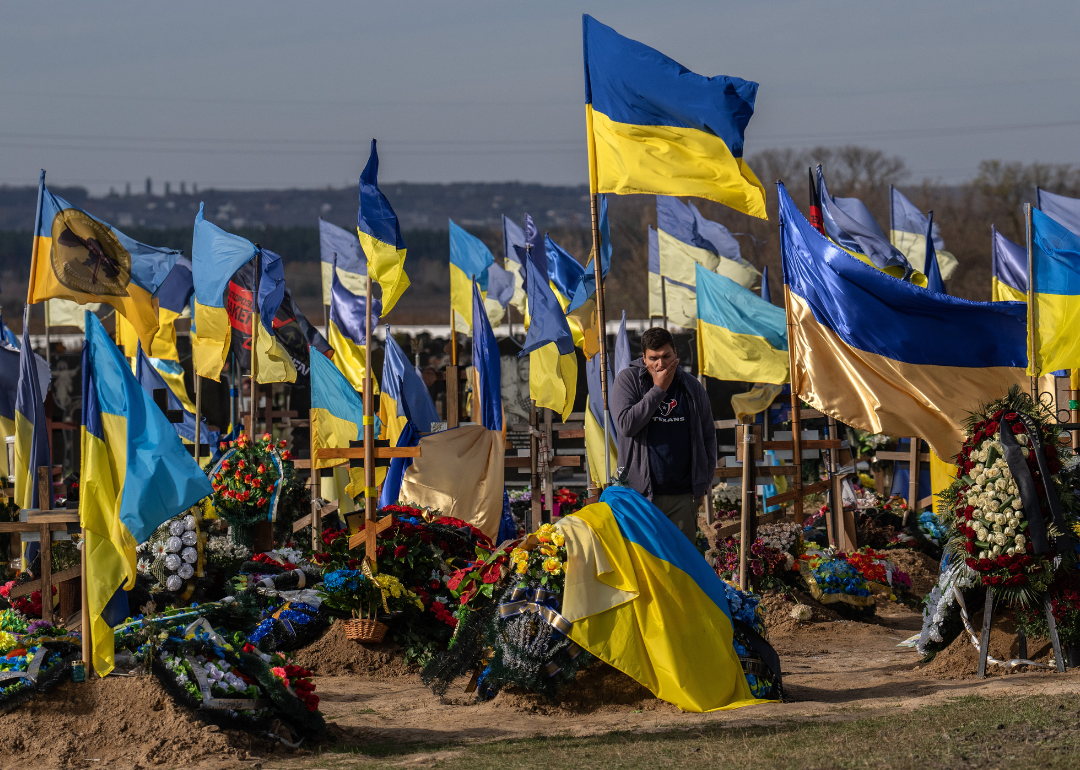
Oil prices and refugees: 7 charts that show how the world has changed since Russia invaded Ukraine
Oil prices and refugees: 7 charts that show how the world has changed since Russia invaded Ukraine
One year ago, Russia invaded Ukraine, violating its sovereignty and territorial integrity, and triggering a chain reaction of geopolitical and economic consequences worldwide. Vladimir Putin's justification for war, he proclaimed, was to "demilitarize and denazify Ukraine" and "bring to trial those who perpetrated numerous bloody crimes against civilians, including against citizens of the Russian Federation," despite a dearth of evidence to support such claims and strong opposition from scholars of Nazism and genocide.
The war's impact on the world at large pales in comparison to what the people of Ukraine have endured. More than 12 million people, 90% of which are estimated to be women and children, have fled or been forcibly removed from their country, and at least 5 million people have been internally displaced. More than 58,000 alleged war crimes—some of which likely amount to crimes against humanity—have been reported across Ukraine.
Still, the war's profound global effects are more accurately labeled as waves, not ripples. The complexity of sanctions and retaliatory bans disrupted commodity exports and prices. Three months into the war, global food prices increased by 30% from the previous year, largely due to the limited cooking oil, fertilizer, and grain exported from Ukraine, according to U.N. Secretary-General António Guterres.
The radiating effect of this lack of food availability, conflated with higher prices, is driving up rates of global starvation and famine. Roughly 345 million people are food insecure. Of those, 50 million people living in 45 countries are approaching famine. While the war in Ukraine is not solely to blame, over the past year it has become a significant driver of global food insecurity and a harbinger of potential famine.
In the United States, the consequences of Russia's invasion were most acutely felt at the gas pump, as crude oil and gasoline prices spiked in response to global market volatility. At its peak, national average prices hit record highs, surpassing $5 per gallon.
The geopolitical ramifications of Russia's war in Ukraine continue to unfold, but they are already beginning to reshape the world. Choosing a side, for many countries, is not just a moral choice. It is an evaluation of alliances, borders, trade relationships, and risk. This is apparent nowhere stronger, perhaps, than in China's position—its Communist government has both endorsed a nonnuclear pledge to the G20 but also voiced its desire to strengthen ties with the Russian Federation and to undermine the effects of global sanctions.
Stacker created seven charts that show how the world has changed since Russia invaded Ukraine one year ago using data from a variety of government, academic, and news sources.
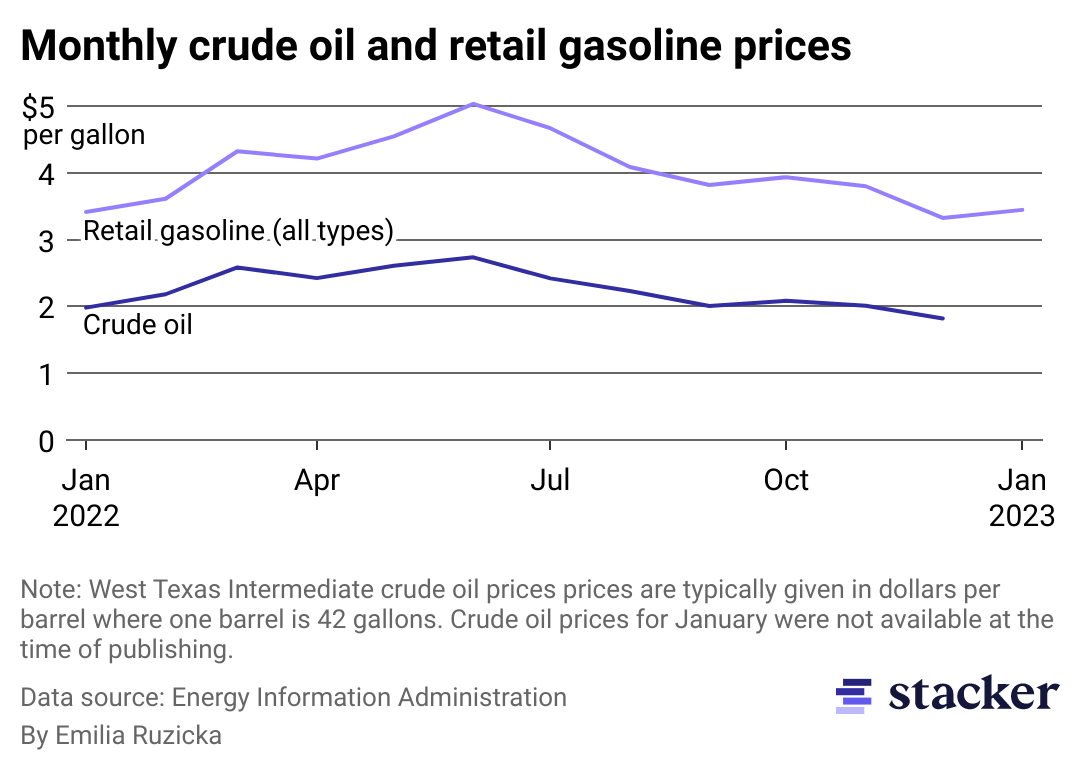
Gas and crude oil prices both peaked in June 2022, four months after Russia's invasion
Even before Russia invaded Ukraine, crude oil prices were rising as economies around the world began to recover from the effects of pandemic-related shutdowns. As global demand grew, crude prices averaged $76 per barrel in January 2022. Roughly a week after the invasion, crude hit a 14-year high of $110 per barrel. Gasoline prices, closely tied to crude prices, subsequently rose sharply, hitting a record high of $5 per gallon in June in the U.S.
In Europe, crude and natural gas prices are expected to rise again in 2023. In February, the EU—the primary market for Russian oil and gas—banned all imports of Russian gasoline, diesel, and other refined oil products used throughout Europe. The bans are an attempt to inflict economic damage on the Kremlin.
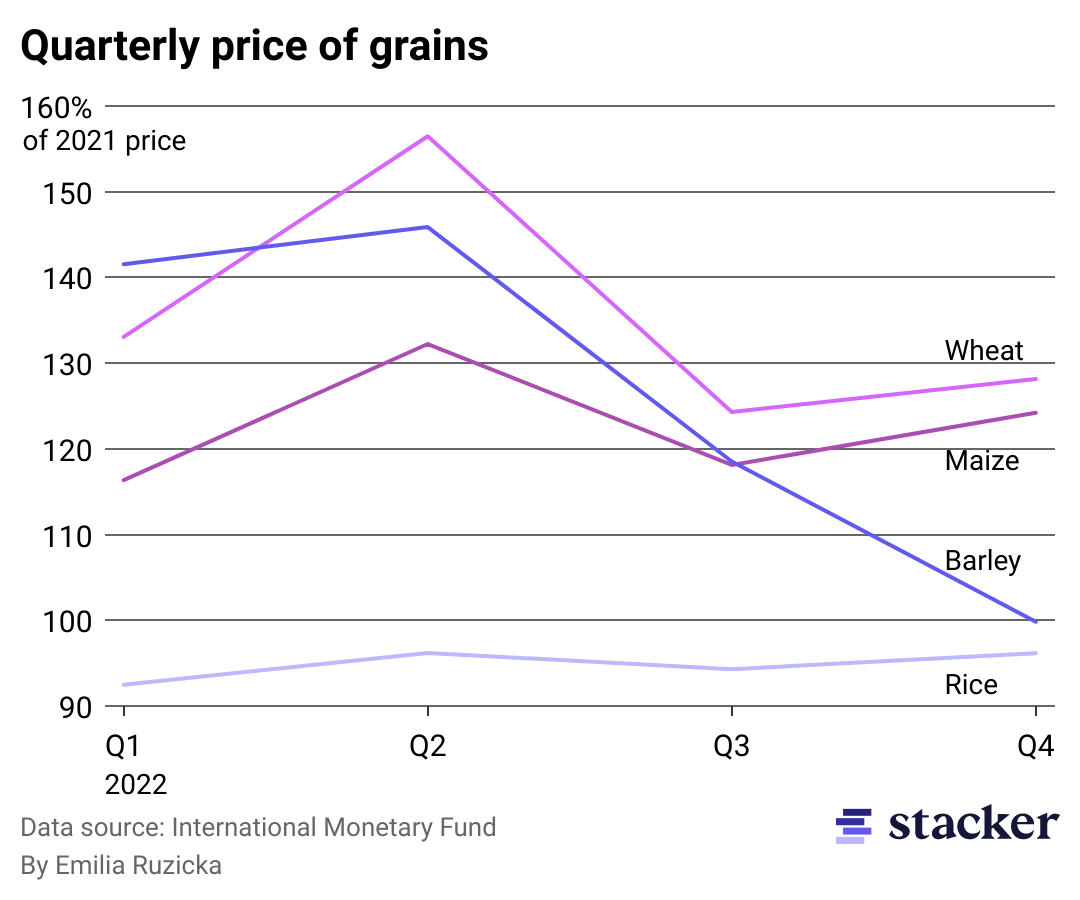
Grain prices climbed in the second quarter of 2022, reflecting the invasion's impact on agriculture
Ukraine is among the world's top agricultural producers and exporters. The Eastern European nation accounts for 15% of the global corn market, 13% of the barley market, and 10% of the wheat market, according to the European Commission. In 2021, its agricultural exports totaled $28 billion.
Russian military vessels have been blocking Ukrainian ports in the Black Sea. On July 22, 2022, the United Nations and Turkey brokered the Black Sea Grain Initiative, which established a safe humanitarian corridor in the Black Sea. Since then, more than 600 ships have departed from Ukrainian ports. The resumed flow of exports helped drive down the price of grain in the second half of 2022.
Due to the destruction of agricultural land by Russian forces, Ukraine estimates it will harvest 51 million metric tons of grain in 2023, down from a record 86 million metric tons in 2021.
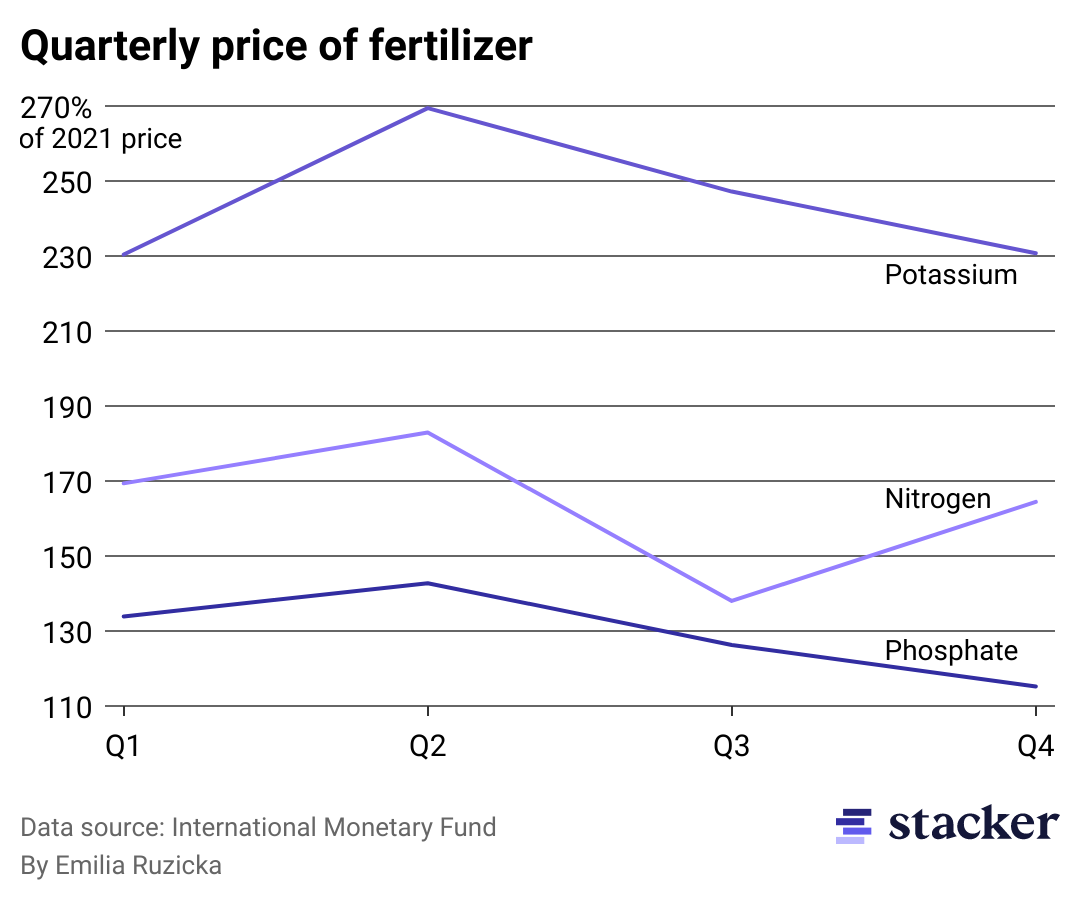
The price of fertilizer rose from Q1 2022 to Q2 2022, but has generally declined since
Russia is a major exporter of urea, ammonia, potash, and other soil nutrients, and produces roughly 25% of the world's nitrogen fertilizer. Sanctions levied against Russia and Belarus have disrupted global exports and increased prices. Additionally, when energy prices increase, so do the prices of fertilizer components that are energy-intensive to produce. For nitrogen in particular, the rising price of natural gas, which is essential to its production, was a driving force behind the price hike. By early 2022, global fertilizer prices rose 30%, following an 80% rise in 2021 due to increased energy, crop, and shipping prices.
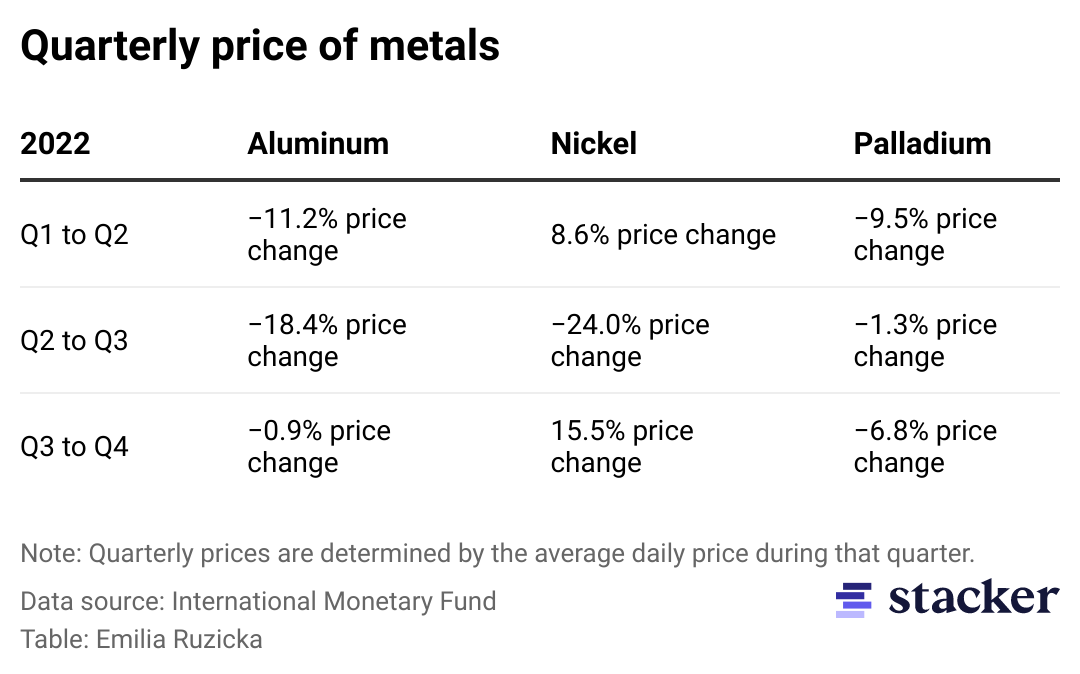
Nickel prices rose twice in 2022, but other raw metal prices declined
Nickel's price hikes in 2022 were not a reflection of scarcity due to sanctions but rather of market volatility—specifically a short squeeze, which is when investors attempt to "squeeze" or countermand the effort of another investor to "short," or bet against a commodity by buying it up in an effort to raise its price value. Nickel, a core component of stainless steel and electric-vehicle batteries, is mined in many countries worldwide. Indonesia produces about three times as much nickel as Russia, but Russia accounts for up to 20% of the world's high-purity nickel production.
In response to sanctions levied against Russia, the Kremlin announced an export ban on 200 products in March 2022. Though the list did not include energy materials or metals, the announcement panicked investors. Nickel prices at the London Metal Exchange more than doubled to about $100,000 per metric ton. As a result, the exchange had to halt the trading of the metal. Since then, the prices have lowered but are still a long way off from pre-war levels. The price of other metals did not follow nickel's trend, primarily because imports, such as that of aluminum, did not flag in the wake of Russia's entry into Ukraine.
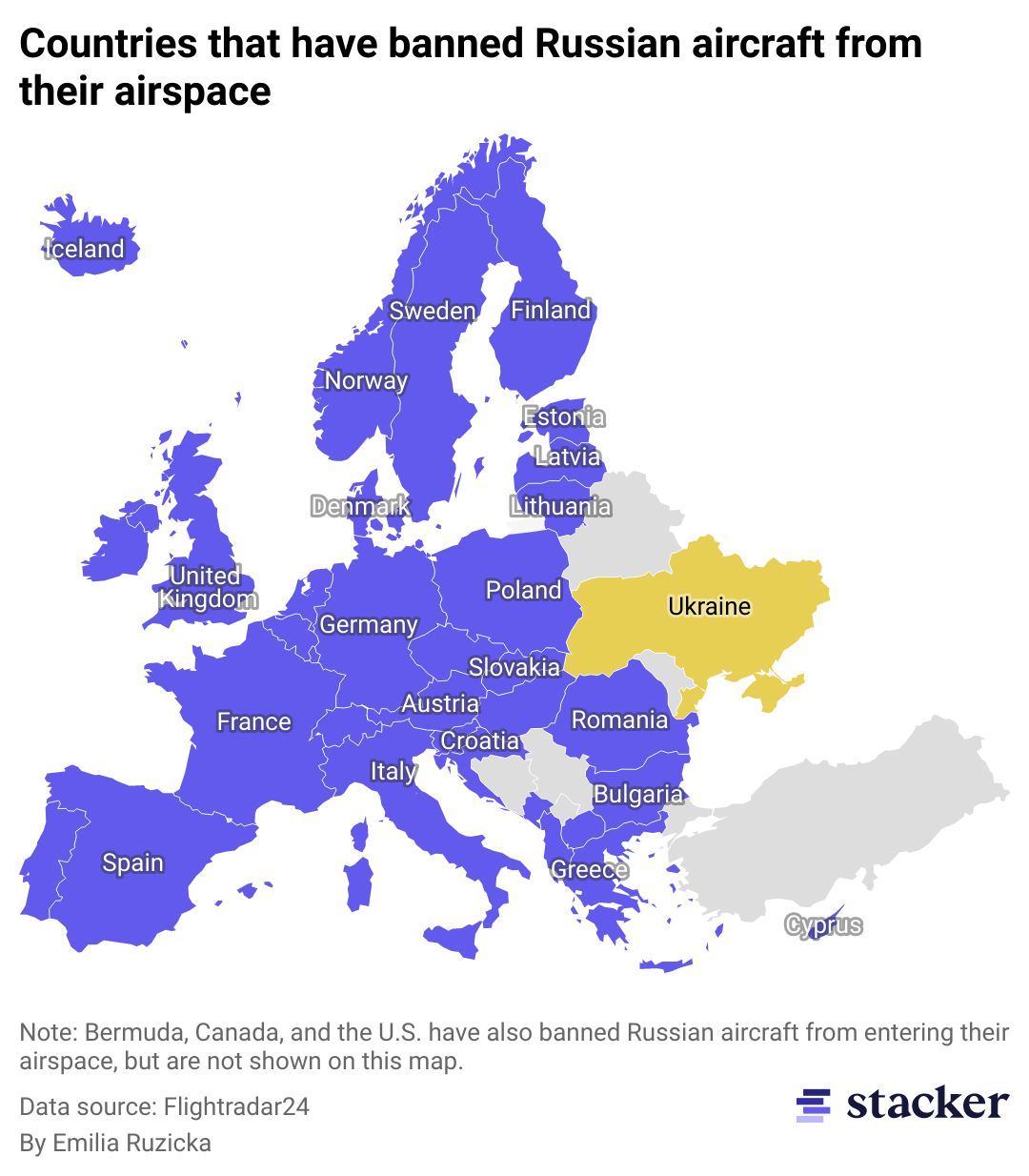
Most countries in Europe have banned Russian aircraft from flying through their airspace
The EU and several other European nations, as well as Canada and the U.S., closed their airspace to any plane owned, chartered, or controlled by a Russian citizen following Russia's invasion.
Russia retaliated with its own bans on all EU countries and others, including the U.K., Canada, and Switzerland. Many of the fastest routes across the northern hemisphere pass through Russian, European, or Canadian airspace. Flights from London to Asia, for example, must fly significantly further south to avoid Russian airspace. For polar routes, fewer refueling opportunities and diversions are available. The need to reroute air traffic means longer flights requiring more fuel, resulting in higher costs and potentially higher risk in the case of an emergency.
Airspace over Ukraine is closed to everyone. In 2014, Malaysia Airlines Flight 17, a commercial jet, was shot down by a Russian missile over the Donbas region of Ukraine during Russia's annexation of Crimea. At the time, Ukraine did not close its airspace.
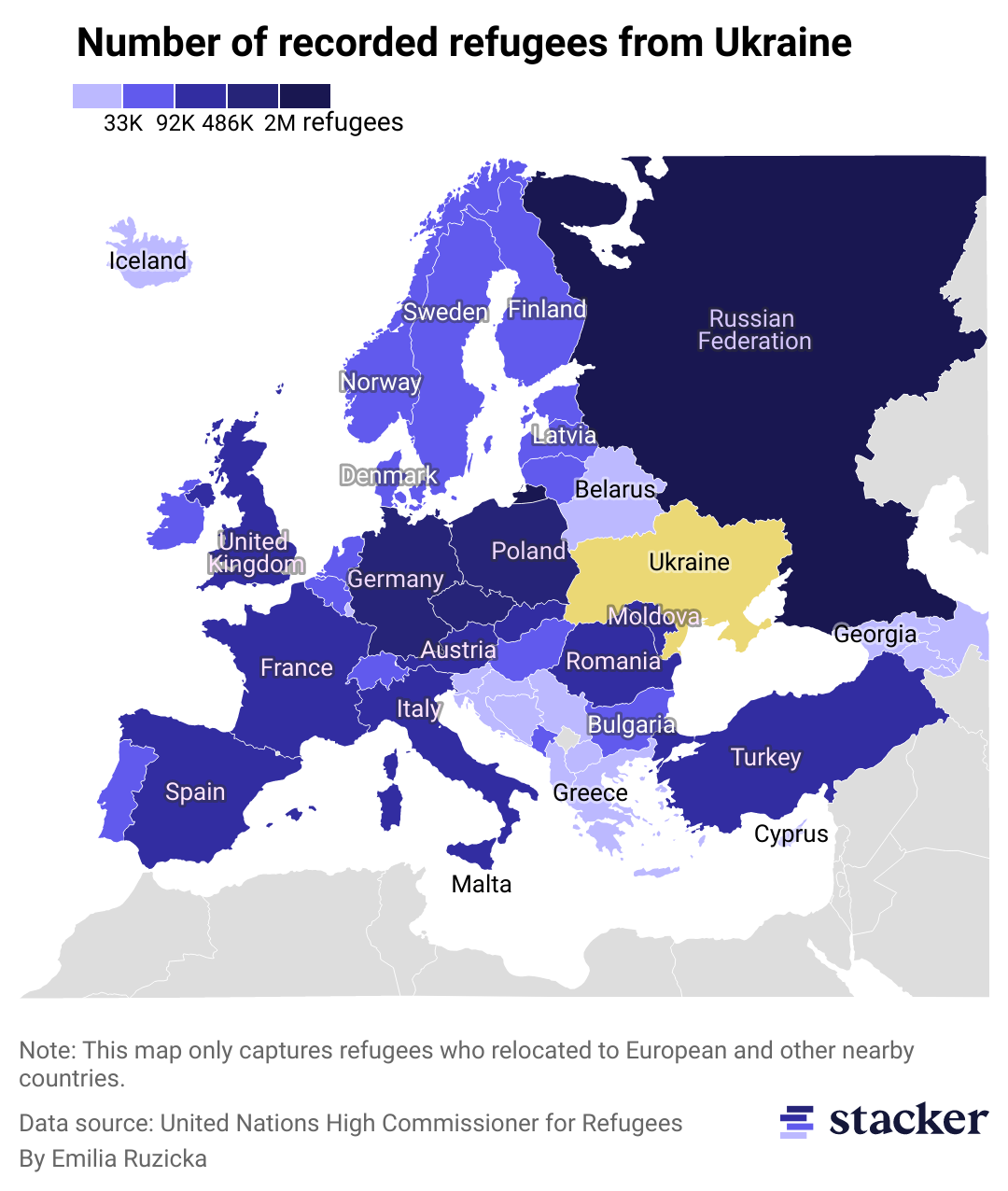
More than 8 million Ukrainian refugees have been recorded across Europe
Russia's invasion triggered a regional forced displacement crisis. Nearly 13 million people—roughly one-third of Ukraine's entire population—have fled to neighboring countries since February 2022, making it one of the worst refugee crises in history. Just over 8 million refugees have been recorded across Europe without official visas or legal protection, while roughly 5 million have registered for temporary protection. The EU's Temporary Protection visas for Ukrainians ensure the right to work, health, education, shelter, and financial support for up to three years.
Poland has received more than 1.5 million displaced Ukrainians, and Germany has granted more asylum visas than any other country. However, the majority of displaced Ukrainian people have been recorded in Russia—and they are, for the most part, forcibly displaced. Human rights watchdogs have documented occurrences of Ukrainians being sent to Russia by Russian occupiers and subjected to a "filtration" process. Ukrainians being "filtered" are photographed, strip-searched for "nationalistic" tattoos, and their fingerprints are recorded. Additionally, their passports are confiscated and their cell phones are searched.
More than 5 million people were still estimated to be internally displaced at the start of 2023. Internal displacement numbers have been declining since August 2022 as regions are reclaimed by Ukrainian forces, according to the International Organization for Migration.
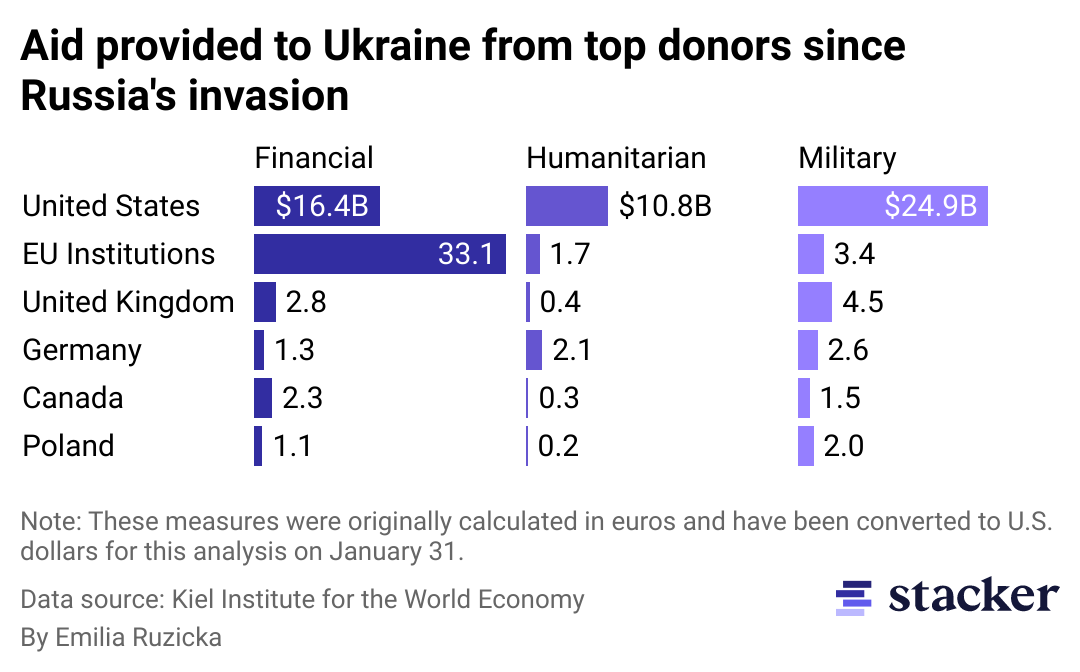
In total, Ukraine has received $123.3 billion in aid since February 2022
According to the Security Assistance Monitor, U.S. military aid to Ukraine between 2003-2013 totaled $504 million. The majority of assistance before 2014 went toward securing Ukraine's nuclear infrastructure through the Cooperative Threat Reduction program, an initiative created to secure and dismantle stockpiles of weapons of mass destruction left behind after the collapse of the Soviet Union.
After Russia illegally annexed Crimea in 2014, Western military support grew. U.S. military aid to Ukraine more than doubled from 2013 to 2014 and then again in 2015. Support continued to grow, with greater investment in foreign military financing, which allows countries to purchase American arms. By the time Russia invaded Ukraine in February 2022, U.S. assistance had already totaled $2.8 billion since 2014. Since then, U.S. military aid alone has reached nearly $25 billion, primarily in the form of defense equipment.
Since 2014, the EU has been the largest donor of humanitarian and development assistance to Ukraine, providing an average of $710 million annually—more than it devotes to any other non-EU country. Additionally, the European Bank of Reconstruction and Development gave $3.8 billion from 2014 to 2017, largely in the form of loans and various investments.



